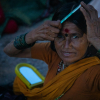Kathiawadi Cuisine
Dr. Desai: Today we enjoyed watching you and learning how to prepare typical Kathiawadi food. Now please tell us how did you make this? What did you use? And where do you get it from?
Saroj: Today we made ringan no olā (roasted/burnt aubergine) and bajri no rotalā (pearl-millet bread)
Dr. Desai: But before that please tell us your name.
Saroj: My name is Saroj Patel
Dr. Desai: So today you showed us how to prepare a typical Patel meal.
Saroj: Yes. Our food, the food of Patels. Today I have prepared ringan no olā, rotala (bread) made of pearl millet, and chillies roasted in a bhattha (coal oven). The chillies are stuffed with coriander-cumin powder (dhana-jira), salt, and lemon juice, roasted in the bhattha.
Dr. Desai: So they are freshly baked/roasted chillies! And then what are the other things that you eat with it?
Saroj: We have butter, milk, roasted kothamada (a sun-dried sour fruit available locally) with it.
Dr. Desai: What is that? In that vessel (bogharani)?
Saroj: It is buttermilk. Rotala can be eaten with buttermilk or milk, butter, ola (roasted/burnt aubergine)whatever one likes
Dr. Desai: Now tell us what is pearl millet (bajaro)? Where do you get it from?
Saroj: It grows on the farm. We are farmers, we Patels. We make Rotala from the bajaro of our farm. All of us eat that with milk or butter. It is very light and easy to digest.
Dr. Desai: So you eat only bajaro or consume wheat also ?
Ramila: We have both. But in winter bajaro is preferred.
Dr. Desai: Now tell us how rotala is made? How do you prepare the dough?
Saroj: The bajara flour must be kneaded well. You have to really knead well with water for a long time till it changes colour. The colour, after kneading for some time, will be white. A light- coloured dough makes the best rotala. To make rotala we make a ball from dough, tap it and rotate to flatten using both the hands. A good rotala needs good kneading and proper tapping when rotating it with both hands. Only then it will rise well. The two layers of rotala should be separate and clearly seen. A good rotala must rise/blow like a ball.
Dr. Desai: I saw Ramilaben bringing an aubergine and placing it on the burning coal in the bhattha when you were making rotala. Why did she do that? What do you do after that?
Saroj: First apply oil on the aubergine and make a hole in it.Then put it in the Bhattha for roasting.
Ramila: So that both can be cooked simultaneously—rotala and aubergine. After the aubergine is completely cooked, take it out and put it on a plate to cool. Peel it and smash it with a flat spoon (tavetha). Chop onions, tomato and green chillies into small pieces. Put oil in a flat vessel, fry the onion, tomato and green chillies to make a paste. Once it turns into a gravy, add the smashed aubergine. Add cumin seeds, turmeric, coriander-cumin powder, asafoetida (hing) and salt. Garnish with coriander leaves and serve with rotala. The masala are as per the taste of each family. Some make it spicier. Some like it bland.
Dr. Desai: These roasted kothimada are here. How do you eat them?
Saroj: They are eaten with rotala, butter, roasted chillies, bharattha and kothimada. This is our Kathiawadi cuisine. Our everyday food.
Dr. Desai: Now tell us who taught you to cook? I cannot make such nice rotala.
Saroj: I learnt from my mother and later from my elder sisters in our kutcha (kitchen) cooked in wood-fire stove (chula). We used an earthen tava (pan) to make a rotala.
Dr. Desai: You mean kaladi? So you make hot rotalas when men return from fields in the evening? And all sit down to eat the piping hot food with homemade fresh butter.
Saroj: Yes. That’s how we eat
Dr. Desai: Thank you very much. We enjoyed learning from you. Now this Kathiawadi meal looks so tempting… let’s eat it. Once again a big thank you to all.












